A) HSCH2CH2OCH2CH3
B) CH3CH2SCH2CH2OH
C) CH3CH2SCH2CH2OCH2CH3
D) CH2=CH2
E) CH3CH3
Correct Answer

verified
Correct Answer
verified
Multiple Choice
An increase in the temperature at which a reaction is carried out increases:
A) the collision frequency.
B) the fraction of molecules with proper orientation.
C) the fraction of molecules with energy greater than Eact.
D) More than one of the above
E) None of the above
Correct Answer

verified
D
Correct Answer
verified
Multiple Choice
A true statement about the transition state(s) of an SN2 reaction is:
A) the two transition states are of unequal energy.
B) the transition states precede and follow an unstable reaction intermediate.
C) the single transition state represents the point of maximum free energy of the reaction.
D) existence of this transition state implies an exothermic reaction.
E) the transition state will always have a net charge of -1.
Correct Answer

verified
Correct Answer
verified
Multiple Choice
Which alkyl halide would you expect to undergo an SN2 reaction most slowly?
A) 1-bromohexane
B) 1-bromo-2-methylpentane
C) 1-bromo-3-methylpentane
D) 1-bromo-4-methylpentane
E) 1-bromo-2,2-dimethylbutane
Correct Answer

verified
Correct Answer
verified
Multiple Choice
The product(s) for the following reaction would mainly be dictated by which mechanism? 
A) SN1
B) SN2
C) E1
D) E2
E) None of the above
Correct Answer

verified
Correct Answer
verified
Multiple Choice
The major product(s) for the following reaction would mainly be dictated by which mechanism? 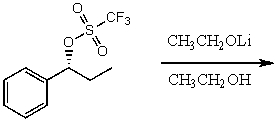
A) SN1
B) SN2
C) E1
D) E2
E) None of the above
Correct Answer

verified
Correct Answer
verified
Multiple Choice
Which alkyl halide would be most reactive in an SN1 reaction? 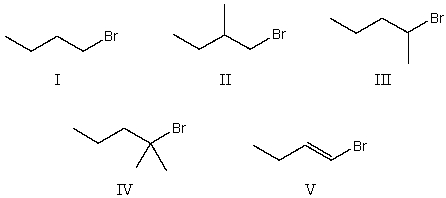
A) I
B) II
C) III
D) IV
E) V
Correct Answer

verified
Correct Answer
verified
Multiple Choice
The major product(s) of the following reaction is(are) : 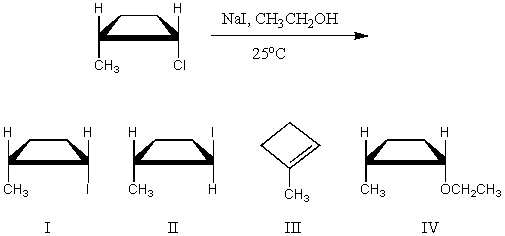
A) I
B) II
C) III
D) IV
E) Equal amounts of I and II
Correct Answer

verified
Correct Answer
verified
Multiple Choice
Select the potential energy diagram that represents a two-step endothermic (endergonic) reaction. 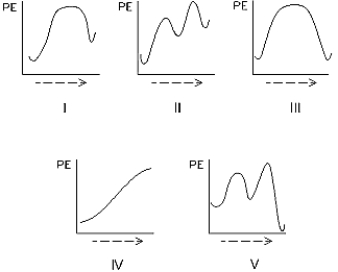
A) I
B) II
C) III
D) IV
E) V
Correct Answer

verified
B
Correct Answer
verified
Multiple Choice
Consider the substitution reaction that takes place when (R) -3-bromo-3-methylhexane is treated with methanol.Which of the following would be true?
A) The reaction would take place only with inversion of configuration at the stereogenic center.
B) The reaction would take place only with retention of configuration at the stereogenic center.
C) The reaction would take place with racemization.
D) No reaction would take place.
E) The alkyl halide does not possess a stereogenic center.
Correct Answer

verified
Correct Answer
verified
Multiple Choice
What would be the major product(s) of the following reaction? 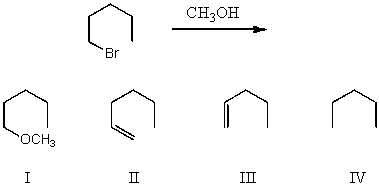
A) I
B) II
C) III
D) IV
E) None of the above
Correct Answer

verified
Correct Answer
verified
Multiple Choice
Treating (CH3) 3C-Cl with a mixture of H2O and CH3OH at room temperature would yield:
A) CH2=C(CH3) 2
B) (CH3) 3COH
C) (CH3) 3COCH3
D) All of these
E) None of these
Correct Answer

verified
Correct Answer
verified
Multiple Choice
Which of the following is not a good leaving group?
A) C2H5O -
B) Cl -
C) I -
D) CH3CO2 -
E) All of these are good leaving groups.
Correct Answer

verified
A
Correct Answer
verified
Multiple Choice
What would be the major product(s) of the following reaction? 
A) I
B) II
C) III
D) IV
E) More than one of the above
Correct Answer

verified
Correct Answer
verified
Multiple Choice
What would be the major product(s) of the following reaction? 
A) I
B) II
C) III
D) IV
E) None of the above
Correct Answer

verified
Correct Answer
verified
Multiple Choice
Consider the SN2 reaction of butyl bromide with OH- ion. CH3CH2CH2CH2Br + OH- CH3CH2CH2CH2OH + Br- Assuming no other changes,what effect on the rate would result from simultaneously doubling the concentrations of both butyl bromide and OH- ion?
A) No effect.
B) It would double the rate.
C) It would triple the rate.
D) It would increase the rate four times.
E) It would increase the rate six times.
Correct Answer

verified
Correct Answer
verified
Multiple Choice
What would be the major product of the following reaction? 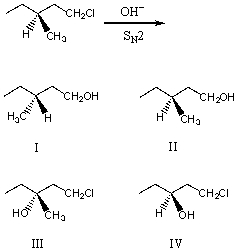
A) I
B) II
C) III
D) IV
E) An equimolar mixture of I and II
Correct Answer

verified
Correct Answer
verified
Multiple Choice
The major product of the following reaction would be: 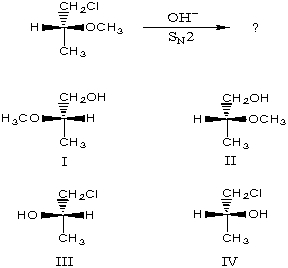
A) I
B) II
C) III
D) IV
E) An equimolar mixture of I and II.
Correct Answer

verified
Correct Answer
verified
Multiple Choice
Identify the leaving group in the following reaction. 
A) C6H5S-
B) Na+
C) CH3CH2I
D) C6H5SCH2CH3
E) I-
Correct Answer

verified
Correct Answer
verified
Multiple Choice
The product(s) for the following reaction would mainly be dictated by which mechanism? 
A) SN1
B) SN2
C) E1
D) E2
E) None of the above
Correct Answer

verified
Correct Answer
verified
Showing 1 - 20 of 146
Related Exams